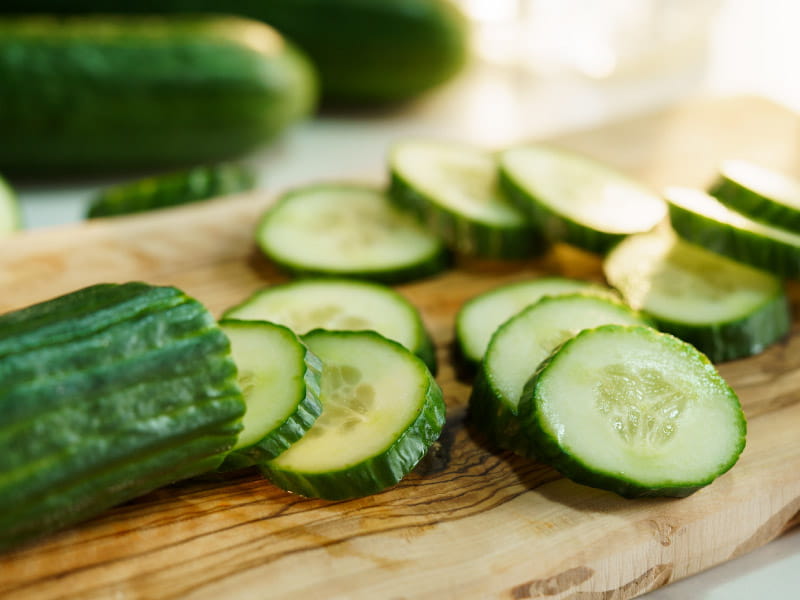Cucumbers are trendy, but how healthy are they?
By Michael Merschel, American Heart Association News

Cucumbers have always been cool. Now, thanks to social media, they're also hot.
Viral cucumber recipes racked up millions of views in the past year, thrusting the salad bar staple into the spotlight. Which might leave you wondering: Healthwise, can cukes endure the glare? Or should they be deleted from your diet?
Unlike some online trends, this is one you can, for the most part, go ahead and sink your teeth into, said Dr. Matthew Landry, an assistant professor of population health and disease prevention at the University of California, Irvine.
"Anytime we can get folks to eat more fruits and vegetables – I love seeing that," Landry said. He calls cucumbers affordable, versatile and a relatively healthy replacement for chips or other snacks.
Generally speaking, cucumbers have "a lot of things in the benefits column," he said, and few negatives. But among those negatives is the fact that "they're not supernutritious."
A cucumber does carry a few nutrients. A predominant one is vitamin K, "which is important in our bodies for blood clotting," he said.
A whole 8 1/4-inch cucumber, with the peel, would have roughly 40% of an adult man's daily recommended amount of vitamin K, or 55% of an adult woman's daily needs, according to the U.S. Department of Agriculture. But that's from the entire cucumber. A more traditional half-cup serving would have about one-sixth the amount of a whole cuke.
Cucumbers also have a bit of vitamins C and A, Landry said. "But again, I would say that the amounts are pretty small, and that's even if you would eat an entire cucumber."
Several medical sources online emphasize cucumbers' potassium levels as helpful in controlling high blood pressure. But Landry said the levels of potassium are small: An entire cucumber would have only 13% of a man's daily needs or 17% of a woman's. Leafy greens such as kale or collard greens would be better sources of that mineral, he said.
Cucumbers have a bit of fiber – 1.5 grams if you eat a whole one – but their lack of bulk means they aren't great at making you feel full. The Food and Drug Administration recommends children ages 4 and older and adults get 28 g of fiber daily. But the nutritional appeal of cucumbers, Landry said, is as much about what they don't have as it is about what they do.
They are at least 95% water, he said. That can help with hydration, but it also means cucumbers are a low-calorie vegetable, with only 45 calories a cuke. "You could eat cups of them, and barely reach 100 calories or so."
Botanically speaking, cucumbers are fruits. But culinarily, they are classified as vegetables due to their nutrient profiles. And like many vegetables, they also have a low glycemic index, making them a good snacking choice for someone with Type 2 diabetes, Landry said.
Their high water content has long made them associated with literal coolness. The phrase "cool as a cucumber" dates to at least the early 1700s.
And while the online world might find them new and exciting, cucumbers – a close relative of both squash and melons – are believed to have originated in the Himalayas and were first cultivated at least 2,500 years ago. Cucumbers were used medicinally in ancient China, India, Rome and Egypt. In the Old Testament, cucumbers were one of the foods the ancient Israelites longed for during their wanderings.
Not everyone feels the same affection. English writer Samuel Johnson is quoted as saying that "a cucumber should be well sliced, and dressed with pepper and vinegar, and then thrown out, as good for nothing."
Landry disagrees, although he has a few words of caution.
Some people peel cucumbers because they don't like the taste or the texture. That lowers what little fiber they provide, he said.
And while their mild flavor means cucumbers can be used in all kinds of fun combinations, "you do still have to watch all the other things that you're mixing in with it," Landry said. Salad dressings, mayonnaise and sauces can be high in sugar or salt and can add unhealthy calories and fat.
No cucumber conversation would be complete without a mention of pickles. Landry acknowledges he's biased: "I love pickles and eat those pretty regularly." But be mindful because pickling can add a lot of sodium. One large pickle can have more than 1,000 milligrams. Federal dietary guidelines recommend most adults eat no more than 2,300 mg of sodium a day; the American Heart Association suggests the ideal daily limit for most adults is 1,500 mg.
One other word of warning: Cucumbers not only went viral this past year, but they were also subject to recalls because of dangerous salmonella. Updates can be found at FDA.gov or foodsafety.gov.
Landry grew up eating home-grown cucumbers in southern Louisiana. "We oftentimes had them in salads," he said. "It adds that crunchiness, which can be really nice."
These days, he puts them on sandwiches or in wraps. He's a fan of Persian or English varieties, which he said tend to be firmer and often have fewer seeds than the common garden version.
The firmer versions work well in a bowl of grain, such as quinoa, orzo pasta or bulgur wheat, he said. For a hearty meal, throw in some bell peppers or other colorful vegetables and season it with a little bit of herbs and maybe a light dressing.
"At the end of the day, it doesn't have a whole lot of calories. It does have some nutrients." And overall, a cucumber "makes a pretty well-rounded snack."
Eat It or Leave It? is an American Heart Association News series that takes a closer look at the health benefits and drawbacks of specific foods and drinks.





